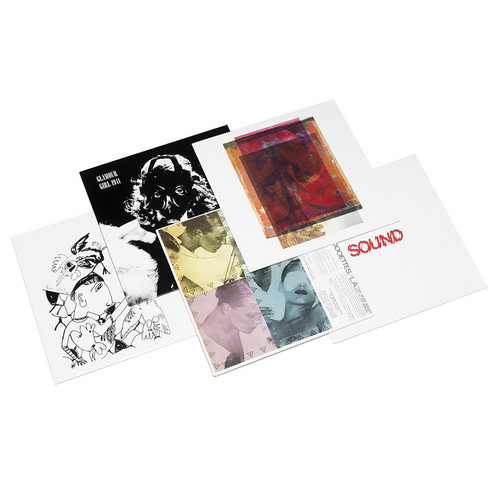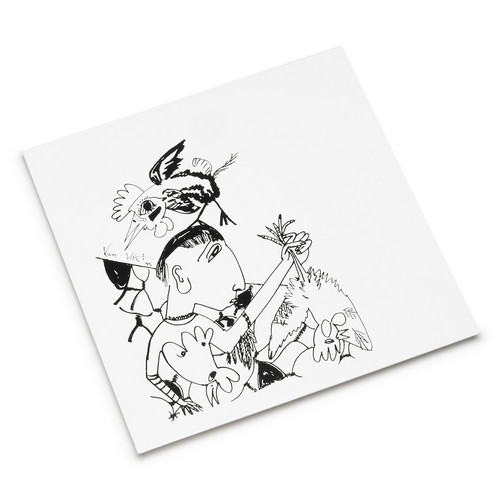★Etats-Unis
Lament For The Rise and Fall of the Elephantine Crocodile
First-time vinyl reissue is limited to 750 numbered copies. Comes with poster. Yoshi Wada's Lament For The Rise And Fall Of The Elephantine Crocodile, originally released in 1982 on India Navigation, remains one of the most remarkable flowers to grow in the rarefied air of American minimalism – akin to Terry Riley's Reed Streams and Pauline Oliveros' Accordion & Voice, yet with a wild, liberated energy all of its own. After graduating from Kyoto University of Fine Arts with a degree in sculptur…
États-Unis Bundle III
Includes five albums: etat16 - Various - I.D. Art #2 (LP) etat17 - Le Forte Four / Doo-Dooettes - Live at the Brand (2xLP) etat18 - Various - Blorp Esette Volume One (LP) etat19 - Smegma - Glamour Girl 1941 (LP) etat20 - Various - Sound (LP)
Glamour Girl 1941
Los Angeles Free Music Society (LAFMS) formed in the mid-1970s as a loose-knit experimental music collective and multimedia publishing vehicle. Founded by teenage Le Forte Four members Chip Chapman, Joe Potts and Rick Potts and soon joined by Tom Recchion of Doo-Dooettes, LAFMS incorporated free improvisation, modular synthesizers, tape music, sampling, musique concrète, homemade instruments, noise, mail art and avant-rock in permissive and anarchic sessions at the Raymond Building and Poo-Bah R…
Blorp Esette Volume One
Los Angeles Free Music Society (LAFMS) formed in the mid-1970s as a loose-knit experimental music collective and multimedia publishing vehicle. Founded by teenage Le Forte Four members Chip Chapman, Joe Potts and Rick Potts and soon joined by Tom Recchion of Doo-Dooettes, LAFMS incorporated free improvisation, modular synthesizers, tape music, sampling, musique concrète, homemade instruments, noise, mail art and avant-rock in permissive and anarchic sessions at the Raymond Building and Poo-Bah R…
Live at the Brand
Los Angeles Free Music Society (LAFMS) formed in the mid-1970s as a loose-knit experimental music collective and multimedia publishing vehicle. Founded by teenage Le Forte Four members Chip Chapman, Joe Potts and Rick Potts and soon joined by Tom Recchion of Doo-Dooettes, LAFMS incorporated free improvisation, modular synthesizers, tape music, sampling, musique concrète, homemade instruments, noise, mail art and avant-rock in permissive and anarchic sessions at the Raymond Building and Poo-Bah R…
I.D. Art #2
Los Angeles Free Music Society (LAFMS) formed in the mid-1970s as a loose-knit experimental music collective and multimedia publishing vehicle. Founded by teenage Le Forte Four members Chip Chapman, Joe Potts and Rick Potts and soon joined by Tom Recchion of Doo-Dooettes, LAFMS incorporated free improvisation, modular synthesizers, tape music, sampling, musique concrète, homemade instruments, noise, mail art and avant-rock in permissive and anarchic sessions at the Raymond Building and Poo-Bah R…
Eight electronic pieces
Originally self-released in 1961 and later issued by Folkways, Tod Dockstader’s Eight Electronic Pieces is a foundational document of American electronic music and astunning first work from this revolutionary composer. Refused access to the resources and funding of the academy and without any interest from the record industry, Tod Dockstader assembled his debut album through three years of his own private labor – recording after-hours at the New York radio station where he worked. Dockstader’sap…
Highlights of Vortex
The brainchild of visual artist Jordan Belson and electronics polymath Henry Jacobs, the Vortex Experiments ran from 1957 to 1960, first at San Francisco’s Morrison Planetarium and later at the SF Museum of Art. The very name of these events announced their aim: a swirling totality of sensory experience. Around Belson’s richly-colored visuals – making use of the planetarium’s entire dome and featuring luminous, sharply geometric imagery projected through an array of devices – Jacobs ringed a sy…







